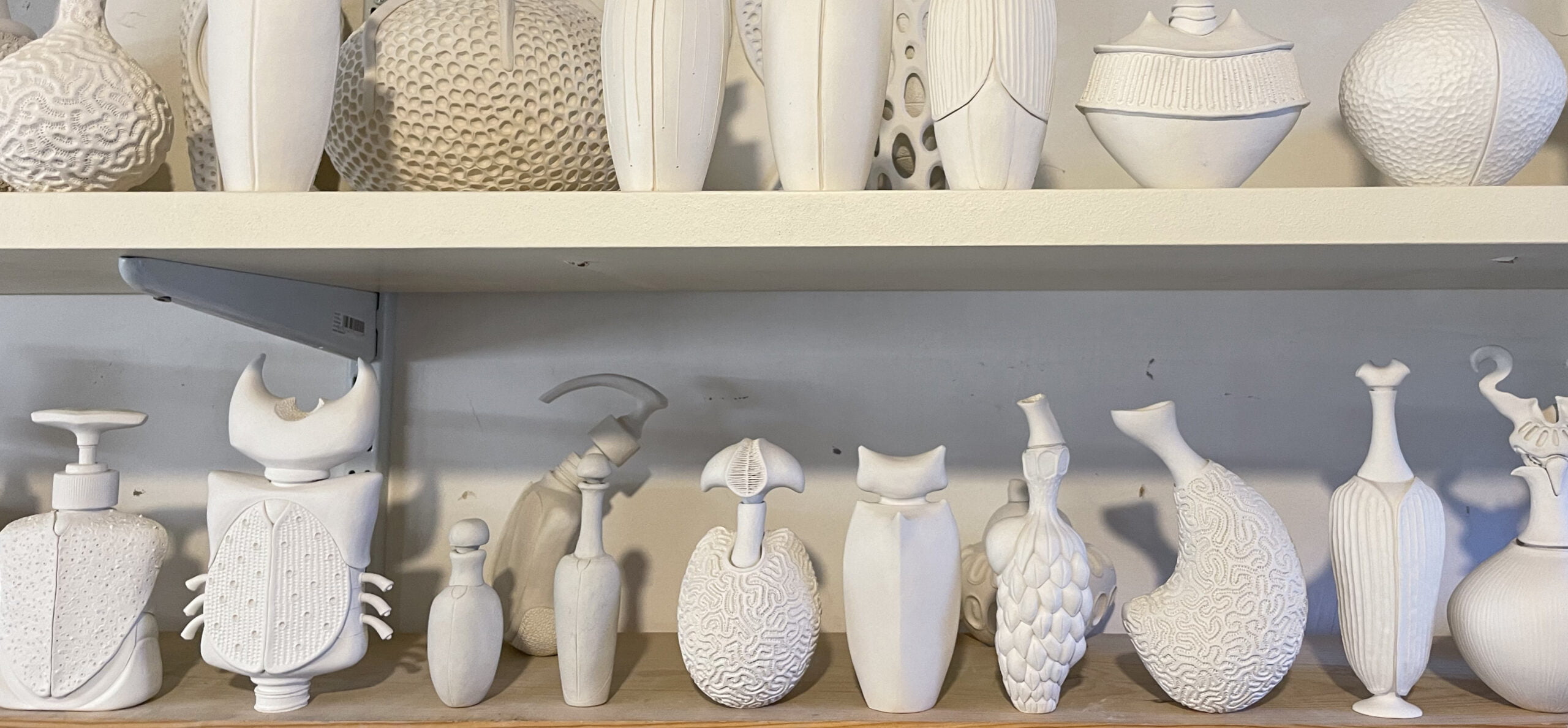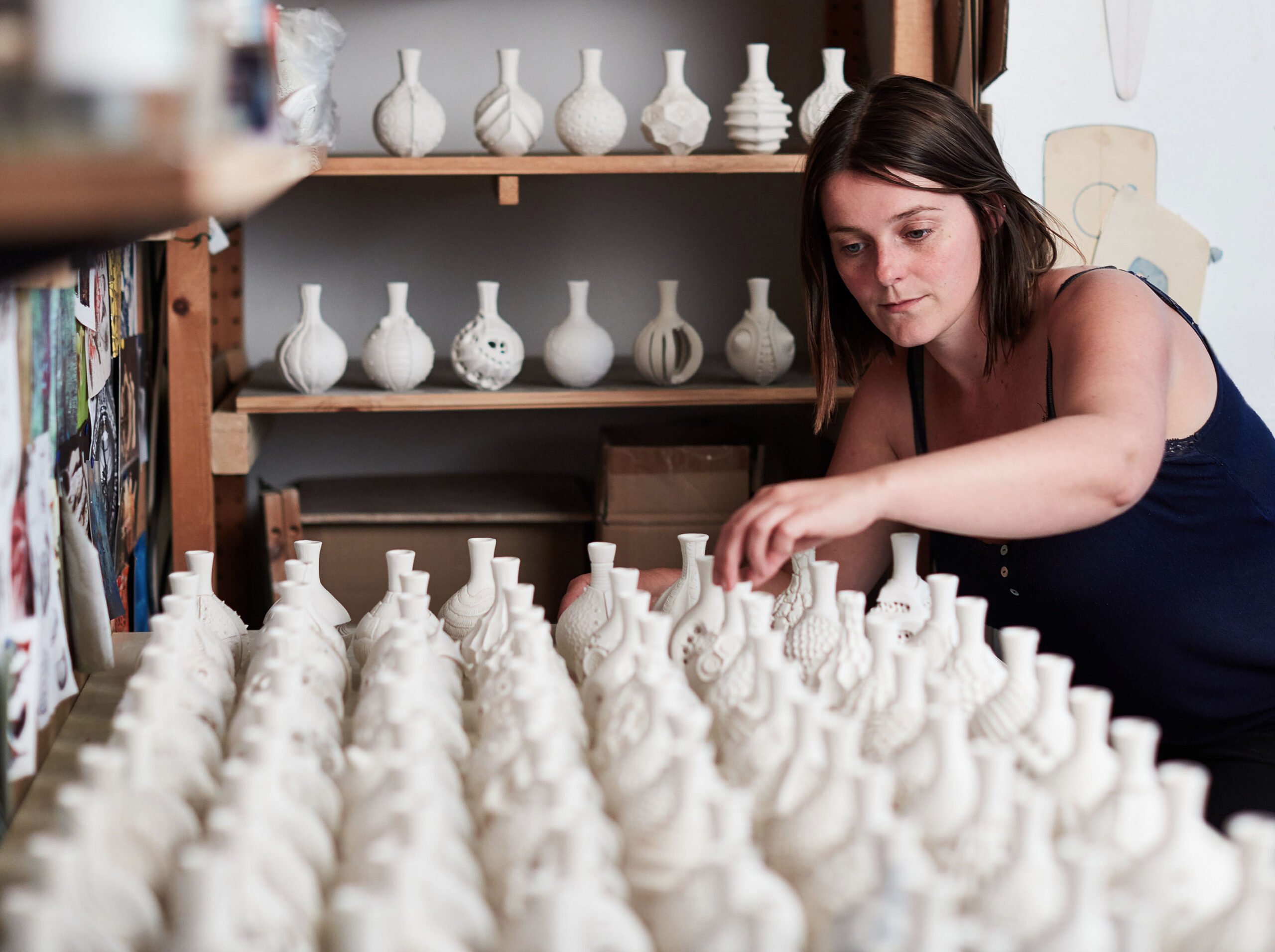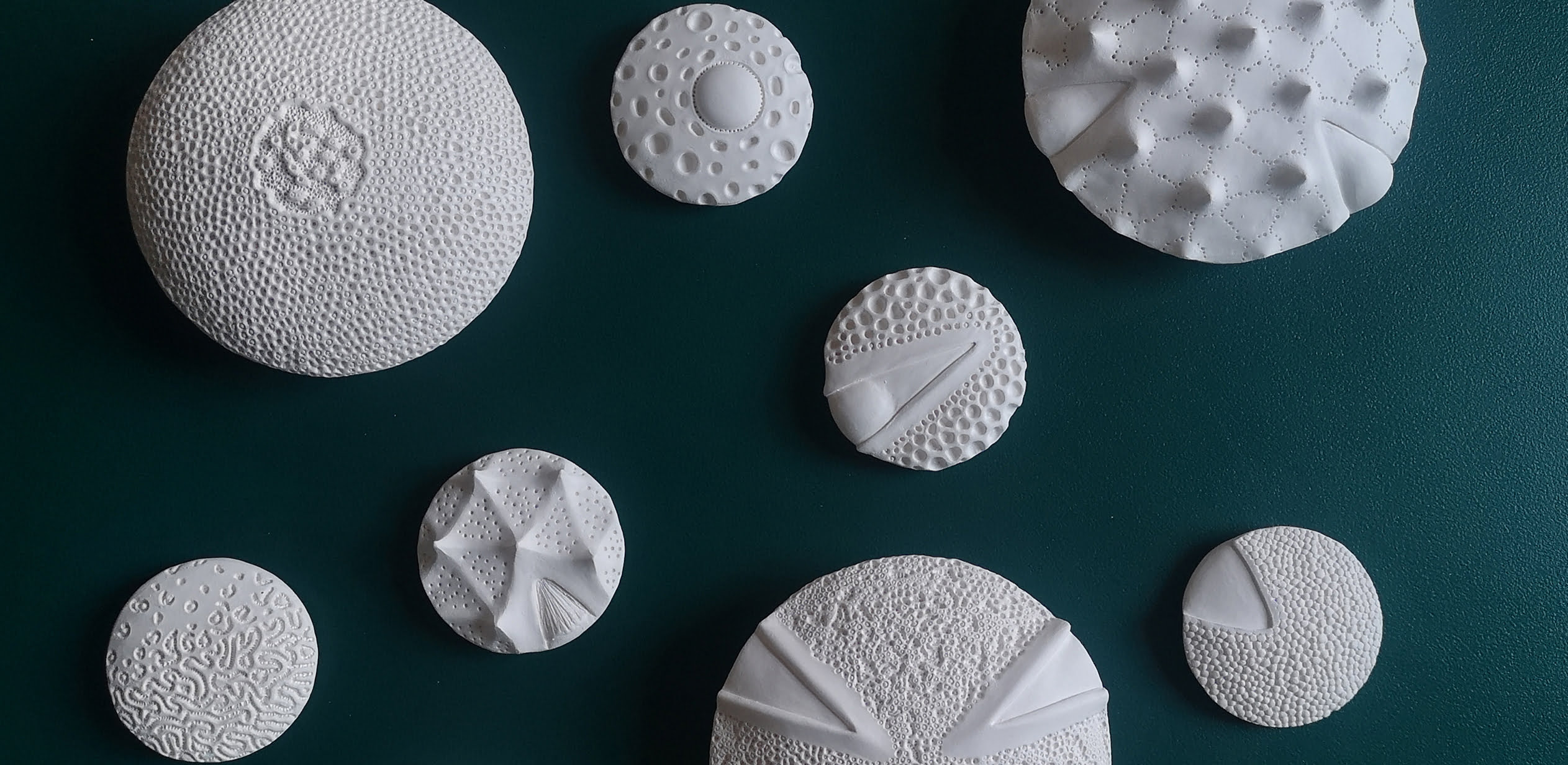Anna Whitehouse uses scientific imagery and research to inform her ceramic sculptures that invite viewers to consider environmental issues. She also works in collaboration with institutes on large-scale public commissions and teaches ceramics to all ages. She strives to create curious objects that spark a childlike sense of wonder and appreciation for the natural world, whilst questioning our place within it. Court Spencer caught up with her at her home studio in Harrogate.

Anna in her lounge, that she also uses as a space for drawing.
Court: Hey Anna. Thank you so much for having me over. It was probably more than ten years ago when visited as part of the North Yorkshire Open Studios. Your place is fab – it’s like a giant cabinet of curiosities! But I hear you’re moving into a new studio space. Can you start by telling us a bit about this place and the studio you’re moving to?
Anna: Yes, I love surrounding myself with curiosities! It subconsciously filters in and affects the work in the studio. I moved into this place in 2010 straight after graduating from Manchester School of Art. When I dug up my backyard to get a greener view from my studio window, I was surprised to find clay down to at least a metre – I didn’t dare keep digging any further! After some research I found the terraces and semis around here were originally built for the workers of a brickworks, that used to be sited on what is now the Oatlands field. The whole area actually used to be called Brickfields, until the well-to-do of Harrogate decided the name wasn’t quite fitting for their fashionable town!
I’ve processed, fired and used this clay in local community projects and it’s a lovely feeling to be in the house working with clay, 150 years after the original clay workers! But it’s now time for a studio move! I desperately need more space and have taken a studio at Workhouse Framing in Starbeck, I get the keys at the beginning of March!
Court: That’s exciting and will be such a big change. But I suppose having some boundaries, more space and your dining room back will be a good thing! So how did you get into art? And were you always going to be an artist?
Anna: It’s going to feel very decadent to have a whole room just for dinning in! The house has always been studio first and home second, but it does feel like the right time to take the next step. With larger installation projects and very productive evening class students, my shelves fill up so quickly here!
I never questioned my direction into art, it was just a given. I have very supportive parents and my Grandma taught me oils, charcoal and observational skills from the age of seven. I’d see her every Saturday morning – we’d put on our smocks, make cups of tea and dive into making!

Work in progress, awaiting glazing.
Court: Your work has a real focus on nature, science and conservation. Have these always been a big influence for you?
Anna: Being out in nature has always been a big part of my life; camping holidays in the French Alps, hiking in the Lakes, fossil hunting the Yorkshire Coast. At uni I was living in the centre of Manchester, a huge concrete jungle and I found the work I was producing in the studio became more and more organic. Clearly, I was pining for more green spaces and natural surfaces!
Court: What drew you to clay as your chosen medium?
Anna: It was after a six-week introduction to ceramics in the first year of my degree. We were taught simple hand building techniques and I quickly realised all the organic forms I had been designing at the time and making in wood or metal, worked so much better in this tactile, squishy material. Then they introduced us to the glaze lab, you mix up a potion, put it in the kiln and see what magic happens – I was hooked!

Anna in the studio with 100 Bottles 100 Days. (Credit: David Lindsay)
Court: You often work in projects or series which gives you scope to really explore a particular topic, and it’s great seeing these on Instagram. Can you tell us about a career highlight?
Anna: To date, my proudest moment was when I had all 100 bottles from my 100 Bottles 100 Days project, displayed in chronological order in my living room/gallery for 2019 North Yorkshire Open Studios. The project was a mammoth making challenge, (make, design and decorate 1 bottle a day for 100 days!) but a huge risk in changing the direction of my practice.
In the past I had given myself a few weeks to experiment, but I knew that if I really wanted to change direction, I had to take the plunge, not apply to any shows, and give myself a significant time to focus.

Pieces from Anna’s current project 100beetles 100days.
Court: And this year you’ve started another 100 days project that you’re involving others in. Where did that idea come from?
Anna: This time I am making a small beetle sculpture every day, adorned with textures and patterns that people around the world suggest, by sending me images via social media. Insects have evolved in all habitats imaginable and represent more than half of all known living organisms on earth. The diversity of their forms, colours, patterns and appendages are breath-taking and for an artist is incredibly inspirational. I hope that the project will encourage people to get out to explore their local area, appreciate insects and their habitats, and in turn help protect these extraordinary creatures which are vital to ecosystems globally.

Pollen Grains in porcelain.
Court: That leads us nicely into pollen. Can you talk a little about your interest in pollen and how that appears in projects?
Anna: The pollen project came about from being asked to make some work for Swarm, an installation piece by Laney Birkhead surrounded by work by other artists focusing on the plight of the honeybee.
I chose to look at the seasonal forage available for pollinators so, armed with the RHS pollinator friendly plant list and a database of scanning electron microscope images, I produced a collection of porcelain studies of pollen grains, covering species that could be easily grown in a UK garden from spring to autumn. I wanted to invite viewers into this hidden microscopic world, be intrigued by the forms and start conversations around what they could do at home to increase local forage.
Court: Do you have a dream project you would love to see happen?
Anna: My dream is a studio that allows me to do whatever project I fancy, not dependant on space and storage! Somewhere that allows me to teach my students more efficiently and productively.
And eventually be able to take my partner on full-time as a technician. Our skill sets are different but complimentary, if we can find a way for the studio to support us and allow us to work together every day, I would be truly content!
Court: That would be amazing and it sounds like you’re definitely working towards that! People can follow your progress on Instagram and Facebook, and via your website. You’re in the exhibition Drawn From The Land that’s on at Sunny Bank Mills until 13 March. Have you got any other exhibitions that we can keep an eye out for?
Anna: The first two weekends in June is North Yorkshire Open Studios, which is back after a two year hiatus. I will be exhibiting all 100 beetles from my current project for the first time - I am so excited!
You can sign up for a free brochure on the NYOS website: www.nyos.org.uk and plan a tour round hidden studio spaces nestled in stunning landscapes, from the dales to the coast!
Court: Thank you so much for your time this morning. It’s been brilliant to chat, see your space and find out more about your work.
Filed under: Art & Photography
Tagged with: art, beetles, ceramics, environment, glazing, insects, organic forms, sculpture, Workshops



Comments